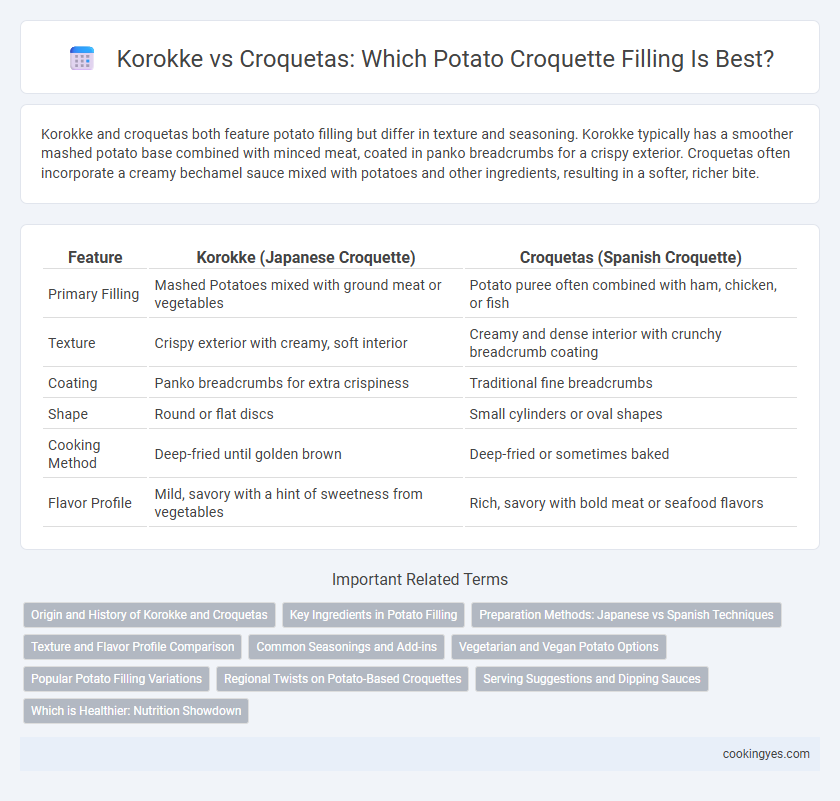Korokke and croquetas both feature potato filling but differ in texture and seasoning. Korokke typically has a smoother mashed potato base combined with minced meat, coated in panko breadcrumbs for a crispy exterior. Croquetas often incorporate a creamy bechamel sauce mixed with potatoes and other ingredients, resulting in a softer, richer bite.
Table of Comparison
| Feature | Korokke (Japanese Croquette) | Croquetas (Spanish Croquette) |
|---|---|---|
| Primary Filling | Mashed Potatoes mixed with ground meat or vegetables | Potato puree often combined with ham, chicken, or fish |
| Texture | Crispy exterior with creamy, soft interior | Creamy and dense interior with crunchy breadcrumb coating |
| Coating | Panko breadcrumbs for extra crispiness | Traditional fine breadcrumbs |
| Shape | Round or flat discs | Small cylinders or oval shapes |
| Cooking Method | Deep-fried until golden brown | Deep-fried or sometimes baked |
| Flavor Profile | Mild, savory with a hint of sweetness from vegetables | Rich, savory with bold meat or seafood flavors |
Origin and History of Korokke and Croquetas
Korokke, a Japanese croquette, originated in the late 19th century, influenced by French croquettes introduced during the Meiji era, typically filled with mashed potatoes mixed with ground meat or vegetables. Croquetas, rooted in Spanish cuisine since the 17th century, often feature creamy potato or bechamel-based fillings with ham, chicken, or seafood, showcasing Spain's affinity for rich, savory snacks. Both variants reflect cultural adaptations of a European concept, emphasizing regional ingredients and culinary traditions in their potato fillings.
Key Ingredients in Potato Filling
Korokke, a Japanese croquette, typically uses mashed potatoes mixed with ground beef, onions, and seasoned with salt, pepper, and sometimes nutmeg to enhance flavor and texture. Croquetas from Spanish cuisine often feature a creamy potato-based bechamel combined with finely shredded meats, such as jamon or chicken, creating a smoother, richer filling. The key difference lies in Korokke's firmer, chunkier potato mix versus Croquetas' velvety bechamel-infused potato filling.
Preparation Methods: Japanese vs Spanish Techniques
Korokke features mashed potatoes mixed with ground meat, coated in panko breadcrumbs, and deep-fried for a crisp, airy texture typical of Japanese cuisine. Croquetas use a thick bechamel sauce combined with finely chopped potatoes, shaped into cylinders, breaded with traditional white breadcrumbs, and fried to create a creamy interior characteristic of Spanish tapas. The Japanese method emphasizes lightness and crunch, while the Spanish technique prioritizes a smooth, rich filling with a delicate crust.
Texture and Flavor Profile Comparison
Korokke features a smooth, creamy potato filling with a subtle sweetness that contrasts its crisp, panko-breaded exterior, creating a light and fluffy texture. Croquetas typically have a denser, creamier mashed potato base blended with bechamel sauce, resulting in a richer, more velvety mouthfeel with savory, seasoned undertones from added ham or cheese. The distinct use of breadcrumbs in korokke offers a crunchier bite compared to the softer, creamier crust of croquetas, making texture a defining factor in their flavor profiles.
Common Seasonings and Add-ins
Korokke and croquetas both feature creamy mashed potatoes as the base, but korokke typically incorporates finely chopped onions and ground meat seasoned with soy sauce, nutmeg, and salt for a savory, umami-rich flavor. Croquetas commonly use bechamel sauce mixed with potatoes, adding ingredients like garlic, onion, parsley, and sometimes ham or cheese, creating a creamier texture and aromatic profile. Both rely on breadcrumbs for a crispy exterior, but their seasoning profiles highlight Japanese subtlety versus Spanish herb and spice intensity.
Vegetarian and Vegan Potato Options
Korokke, a Japanese croquette, typically features mashed potatoes blended with onions and coated in panko breadcrumbs, offering a crispy texture suited for vegetarian diets without dairy or eggs if prepared traditionally. Croquetas, popular in Spanish cuisine, often incorporate mashed potatoes mixed with bechamel sauce, making them less ideal for vegan diets unless dairy substitutes are utilized. Both offer versatile potato fillings, but korokke provides a more straightforward plant-based base, making it a preferred choice for vegan and vegetarian potato croquettes.
Popular Potato Filling Variations
Korokke, a popular Japanese croquette, typically uses a mashed potato filling combined with ground meat and onions, seasoned with soy sauce for a savory flavor. Croquetas, commonly found in Spanish cuisine, feature a creamy bechamel sauce mixed with finely chopped ham or chicken, but potato-filled versions use mashed potatoes blended with garlic and herbs for a smooth texture. Both variations highlight regional preferences in seasoning and texture, with Korokke emphasizing a firm, flavorful potato base and Croquetas favoring a rich, creamy potato filling.
Regional Twists on Potato-Based Croquettes
Korokke, a Japanese take on croquettes, typically features mashed potatoes mixed with ground meat or seafood, coated in panko breadcrumbs, and deep-fried for a crispy texture. Spanish croquetas often use a creamy bechamel base combined with finely chopped potatoes, resulting in a softer, creamier filling than Korokke. Regional variations emphasize local ingredients and texture preferences, with Korokke highlighting a crunchy exterior and croquetas favoring a smooth, velvety interior.
Serving Suggestions and Dipping Sauces
Korokke, a Japanese croquette typically filled with mashed potatoes mixed with ground meat or vegetables, is often served hot and accompanied by tonkatsu or Worcestershire-based sauce for a tangy flavor. Croquetas, a Spanish counterpart, usually feature a creamy potato bechamel filling and pair well with aioli or smoky romesco sauce to enhance their rich texture. Serving korokke with shredded cabbage and croquetas alongside a fresh salad highlights their complementary cultural presentations and broadens their savory appeal.
Which is Healthier: Nutrition Showdown
Korokke and croquetas both use mashed potatoes as a base, but korokke typically contains fewer calories and less fat due to lighter breading and frying methods. Croquetas often incorporate richer ingredients like bechamel sauce and cheese, increasing their saturated fat and sodium content. Choosing korokke offers a healthier option for potato-filled snacks with lower overall fat and calorie density.
Korokke vs Croquetas for potato filling Infographic

 cookingyes.com
cookingyes.com